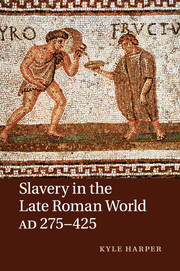Book contents
- Frontmatter
- Contents
- List of tables
- Acknowledgments
- PART I THE ECONOMY OF SLAVERY
- Introduction
- 1 Among slave systems: a profile of late Roman slavery
- 2 The endless river: the supply and trade of slaves
- 3 Oikonomia: households, consumption, and production
- 4 Agricultural slavery: exchange, institutions, estates
- PART II THE MAKING OF HONORABLE SOCIETY
- PART III THE IMPERIAL ORDER
- CONCLUSION
- APPENDIXES
- Bibliography
- Index
2 - The endless river: the supply and trade of slaves
Published online by Cambridge University Press: 05 August 2011
- Frontmatter
- Contents
- List of tables
- Acknowledgments
- PART I THE ECONOMY OF SLAVERY
- Introduction
- 1 Among slave systems: a profile of late Roman slavery
- 2 The endless river: the supply and trade of slaves
- 3 Oikonomia: households, consumption, and production
- 4 Agricultural slavery: exchange, institutions, estates
- PART II THE MAKING OF HONORABLE SOCIETY
- PART III THE IMPERIAL ORDER
- CONCLUSION
- APPENDIXES
- Bibliography
- Index
Summary
STUDYING THE ROMAN SLAVE SUPPLY
The definition of slavery in Roman law and ideology blended the imaginary order in which slavery was the rightful outcome of Roman conquest and the mundane, material fact of the slave trade. It is important, analytically, not to conflate the two. The Roman slave system was not in any simple sense the product of wars of conquest, and the slave supply was not a direct function of military expansion. Over the last generation, there has been a new recognition that it is necessary to account for the extraordinary movement of human bodies that was the Roman slave trade, without the easy, ideological explanation of mass warfare. In retrospect, the theory of conquest has never been able to offer a very detailed story of how millions of captives could be filtered through an infrastructure of trade, or how a massive sudden influx of slaves would be absorbed in society – consumed, managed, and exploited. More importantly, if war was instrumental in the generation of Roman slavery, it does not perforce follow that the end of conquest reversed the trajectory of the slave system, leading inevitably to a reduction in supply, a rise in prices, and overall decline.
- Type
- Chapter
- Information
- Slavery in the Late Roman World, AD 275–425 , pp. 67 - 99Publisher: Cambridge University PressPrint publication year: 2011

